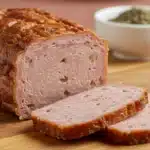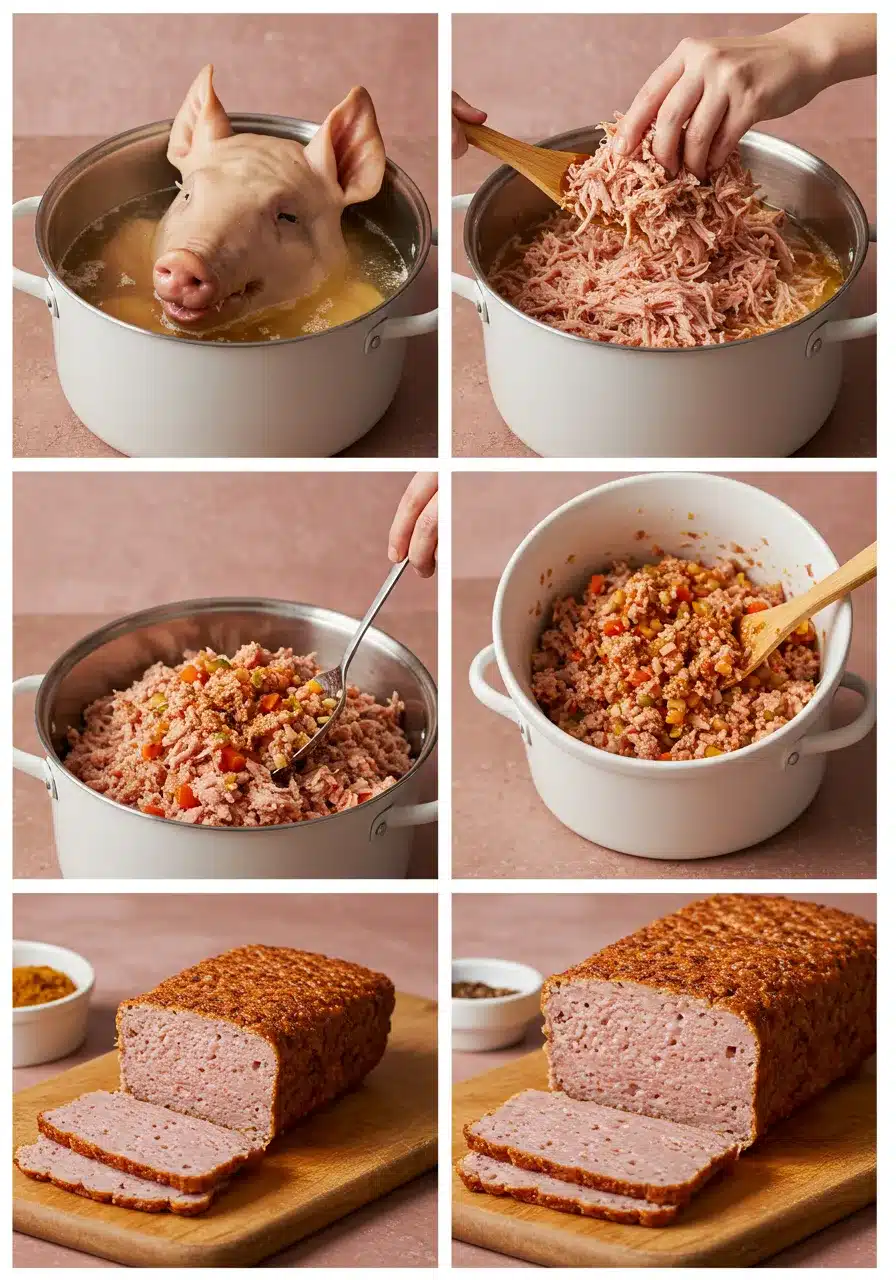Hey there, welcome back to Recipes2Gather! If you’re ready to explore something savory, traditional, and packed with bold flavor, you’re in for a treat. Today we’re diving into the Southern delicacy known as hog head cheese—a dish that sounds unusual but delivers mouthwatering results when made right.
Despite the name, hog head cheese isn’t a dairy product at all. It’s a meat jelly made from parts of a pig’s head, often seasoned with onions, vinegar, and spices, then chilled until firm. It’s a cultural icon in Southern cooking, especially in Cajun and Creole kitchens, where it’s served cold on crackers, bread, or alongside pickled veggies.
If you’ve never tried making it at home, don’t worry—it’s more approachable than it sounds. And once you do, you’ll appreciate why it’s cherished for its rich taste, rustic charm, and make-ahead convenience. For more classic bites with deep roots, you might also enjoy our guide to pimento cheese or dive into the tangy world of port wine cheese spread.
Print
Hog Head Cheese That’s Bold Flavor in Every Bite
- Total Time: 4 hours 30 minutes
- Yield: 2 loaves
- Diet: Gluten Free
Description
This traditional Southern hog head cheese is a savory, set meat jelly that’s rich in flavor and perfect for slicing, snacking, or sandwiches.
Ingredients
- 1 whole pig’s head (halved)
- 2 cloves garlic
- 2 onions, chopped
- 1 cup celery, chopped
- 1 bell pepper, diced
- 1 tbsp red pepper flakes (optional)
- Salt and black pepper to taste
- 1 tsp paprika
- 1/4 cup white vinegar
- 1 packet unflavored gelatin (optional)
Instructions
- Clean Pig Head: Rinse and scrub thoroughly, removing any hairs.
- Boil: Cover with water in a large pot and simmer 3–4 hours.
- Shred Meat: Cool slightly, then pull meat off bones. Reserve broth.
- Cook Veggies: Sauté garlic, onion, celery, and bell pepper until soft.
- Mix Together: Combine shredded meat, veggies, spices, vinegar, and broth. Simmer.
- Test Consistency: Add gelatin if needed.
- Set in Mold: Pour into molds and refrigerate overnight.
- Slice and Serve: Chill until firm. Serve cold.
Notes
- Customize spice levels to taste.
- Set in individual portions for easier serving.
- Keeps in fridge up to 1 week.
- Prep Time: 30 minutes
- Cook Time: 4 hours
- Category: Appetizer
- Method: Boil, Chill
- Cuisine: Southern
Key Benefits
You might wonder why anyone would take the time to make hog head cheese from scratch. So why should you give it a try? Here’s what makes it worth it:
- Flavor Like No Other: There’s nothing quite like it. The mix of tender pork pieces and rich, spiced gelatin creates a savory, tangy bite that’s deeply satisfying.
- Nose-to-Tail Cooking: Hog head cheese makes use of parts of the animal that are often overlooked. It’s a budget-friendly, respectful way to reduce food waste and honor traditional cooking.
- Make-Ahead Friendly: Once it sets, it keeps in the fridge for days, making it perfect for snacks, lunches, or party trays.
- Customizable: Love garlic? Want it spicy? Prefer a smooth finish over chunky? You can tailor this recipe to your taste with simple adjustments.
- Cultural and Culinary Heritage: Especially in Southern and African-American homes, this dish carries history and pride. It’s a conversation piece at gatherings and often a cherished family recipe.
As with other rooted traditions like our beloved mac and cheese bowl, hog head cheese is a soulful, flavorful expression of regional cooking that’s worth preserving—and enjoying.
Ingredients for Hog Head Cheese
While the ingredient list may seem a bit old-fashioned, it’s straightforward and rich in flavor. Here’s what you’ll need:

- 1 whole pig’s head (halved or quartered) – cleaned thoroughly
- 2 cloves garlic – crushed
- 2 medium onions – chopped
- 1 cup celery – chopped
- 1 bell pepper – diced
- 1 tablespoon red pepper flakes – optional, for spice
- Salt and black pepper – to taste
- 1 teaspoon of paprika – brings a pop of color and a mellow, smoky taste
- 1/4 cup white vinegar – adds tang and helps preserve
- 1 packet unflavored gelatin (optional) – only if needed for extra firmness
The magic lies in simmering these ingredients slowly to pull out the natural collagen and gelatin in the meat and bones. For those interested in mastering classic techniques like this, our hog head cheese guide offers even more detail on ingredient prep and seasoning blends.
Step-by-Step Instructions for Hog Head Cheese
Making hog head cheese may take a few hours, but it’s more about patience than skill. We’ll break it down step by step—it’s simpler than it sounds:

- Clean and Prep: Rinse the pig’s head well. Remove any hairs and scrub thoroughly. Place it in a large stockpot and cover with cold water.
- Simmer: Simmer it low and slow—after it comes to a boil, let it gently bubble for 3 to 4 hours. Skim off any foam. You’ll know it’s done when the meat pulls away easily from the bone.
- Strain and Shred: Take the head out and let it cool a bit, then pull off the good meat and toss anything tough or bony. Reserve the stock.
- Cook With Veggies: In a separate pan, sauté the onions, garlic, celery, and bell pepper until soft. Add them to the shredded meat.
- Season and Simmer Again: Return meat and veggies to the pot. Add spices, vinegar, and continue to simmer for 20 minutes.
- Test for Set: If the stock is thick enough to gel when chilled, great! If not, dissolve a bit of unflavored gelatin into the mix.
- Mold and Chill: Pour into loaf pans or molds. Pop it in the fridge and let it firm up—give it a few hours or just leave it overnight.
- Slice and Serve: Once firm, slice like a cold cut. It’s ready to enjoy!
Pro Tips and Variations for Hog Head Cheese
Once you’ve got the basics down, try these tweaks to make the recipe your own:
- Add Heat: Stir in cayenne pepper or diced jalapeños for a spicy version.
- Smooth or Chunky?: Pulse the final mix in a food processor for a smoother texture—or leave it rustic and hearty.
- Fresh Herbs: Add parsley, thyme, or bay leaves for aromatic flavor.
- Vinegar Varieties: Apple cider vinegar adds a sweeter tang than white vinegar.
- Make It Snack-Ready: Set it in small ramekins for individual portions that are great for charcuterie boards.
This recipe works beautifully as part of a larger spread. Consider serving it with cheese crackers or our grilled cheese and jam sandwich for contrast.
Serving Suggestions for Hog Head Cheese
Hog head cheese is traditionally enjoyed cold, and there are plenty of tasty ways to plate it:
- Cracker Stackers: Top with a dollop of hot mustard or pickled okra for a snack or appetizer.
- Charcuterie Boards: Slice thin and pair with cured meats, pickles, and sharp cheese.
- Po’boy Style: Pile on crusty bread with lettuce, tomato, and mayo for a true Louisiana-style sandwich.
- Southern Breakfast: Serve with eggs, grits, and toast for a hearty start to your day.
- Party Tray: Cut into cubes and serve with toothpicks alongside deviled egg trays and dips.
Trasted Ressources Related to Hog Head Cheese
- Learn how collagen plays a role in dishes like hog head cheese in this Healthline article on gelatin and bone broth.
- Serious Eats explores aspic and gelatin-based terrines, perfect for understanding hog head cheese’s texture.
Conclusion
Hog head cheese is one of those old-school recipes that deserves a spot on your table. It’s resourceful, full of character, and incredibly flavorful when made with care. From Sunday suppers to holiday spreads, this dish brings heritage and heart to every bite.
We hope you feel inspired to try it yourself—it’s a rewarding way to experience a cherished piece of culinary history. And if you love bold comfort foods, don’t miss our smoked mac and cheese for your next meal plan.
FAQs
Nope! It’s called “cheese” because of the way it sets in a loaf and can be sliced. It contains no dairy.
Mostly the head—jowls, cheeks, and other tender bits. These parts are full of flavor and collagen for natural gelling.
Absolutely. Some recipes mix in pork shoulder or even turkey for variety, but the classic method uses pig head for authenticity.
Yes—just be sure the meat is fully cooked and cooled properly. Keep it chilled in the fridge and try to finish it up within seven days.
It’s firm and sliceable, like a pâté or aspic, with a savory, meaty bite.

